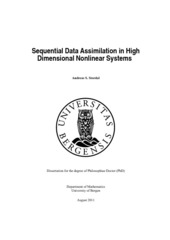Sequential Data Assimilation in High Dimensional Nonlinear Systems
Doctoral thesis
Permanent lenke
https://hdl.handle.net/1956/5178Utgivelsesdato
2011-10-21Metadata
Vis full innførselSamlinger
Sammendrag
Since its introduction in 1994, the ensemble Kalman filter (EnKF) has gained a lot of attention as a tool for sequential data assimilation in many scientific areas. Due to its computationally fast and easy to implement algorithm its popularity has increased vastly over the last decades especially in the fields of oceanography and petroleum engineering. Although EnKF has been successfully applied to many real world problems it has a major drawback from a statistical point of view. The algorithm only converge to the optimal solution if the system under consideration is linear and all random variables describing the system are Gaussian. There exist sequentialMonte Carlo methods (SMC) with correct asymptotic properties, but both numerical and theoretical studies have shown that the number of samples must increase exponentially with the dimension of the model to avoid a collapse of the algorithm. For large scale geophysical systems, such as petroleum reservoirs or ocean models, each sample requires the solution of a system of partial differential equations on a large grid. The computational burden of solving these equations using numerical schemes naturally puts an upper limit on the number of samples we can use in practice. Hence these sequential Monte Carlo methods are not applicable, at least in their simplest form, in large scale geophysical models. This thesis explores the possibility of bridging the gap between EnKF and one of the asymptotically correct SMC methods, known as particle filters, by extending already known theory on Gaussian mixture filters. In addition a sensitivity analysis is carried out for a new type of data in reservoir models. A new approximative filter is developed by introducing an additional parameter in the standard Gaussian mixture filter. The adaptive Gaussian mixture filter (AGM) consists of two parameters and by choosing these differently the filter may run as EnKF, a particle filter, or something in between. The method is tested on the Lorenz96 model for comparison with EnKF and Gaussian mixture filters. Further comparison with EnKF is made after running AGMon a 2D two-phase and a 3D three-phase petroleum reservoir. We generalize AGMand compute error bounds and asymptotic properties using classical approximation techniques before we explore the effects of estimating the first and second order moments locally in Kalman type filters. By local estimation we mean local in value and not in space. Two different approaches are suggested and applied to the chaotic Lorenz63 model and a 1D reservoir model. Finally the sensitivity of reservoir parameters to a new type of data, nanosensor observations, are calculated. Both analytical and numerical results are provided. A simulation experiment is included from which we can compute the resolution of the estimated parameters numerically.
Består av
Paper A: Andreas S. Stordal, Hans A. Karlsen, Geir Nævdal, Hans J. Skaug and Brice Vallès, Bridging the Ensemble Kalman filter and particle filters: The adaptive Gaussian mixture filter. Computational Geosciences 15(2): 293-305, September 2011. Full text not available in BORA due to publisher restrictions. The article is available at: http://dx.doi.org/10.1007/s10596-010-9207-1Paper B: Andreas S. Stordal, Hans A. Karlsen, Geir Nævdal, Hans J. Skaug and Randi Valestrand, Comparing the adaptive Gaussian mixture filter with the ensemble Kalman filter on synthetic reservoir. Full text not available in BORA.
Paper C: Andreas S. Stordal and Hans A. Karlsen, A generalization of the adaptive Gaussian mixture filter with error bounds and large sample asymptotics. Full text not available in BORA.
Paper D: Andreas S.Stordal, Hans A. Karlsen, Geir Nævdal, Dean S. Oliver and Hans J. Skaug, Filtering with local Kalman gain. Full text not available in BORA.
Paper E: Andreas S. Stordal and Dean S. Oliver, Characterization of permeability and porosity from Nanosensor Observations. Advances in Water Resources 34(8): 946-956, August 2011. Full text not available in BORA due to publisher restrictions. The article is available at: http://dx.doi.org/10.1016/j.advwatres.2011.04.015
